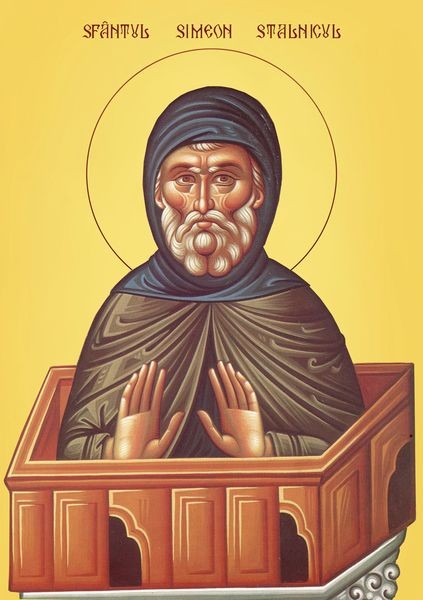Venerable Simeon Stylites
 September 14 (Sept.1 old calendar).
September 14 (Sept.1 old calendar).
Saint Simeon was born into a poor family living in the Antioch area of Syria in the middle of the 4th century. Once when he was in church listening to the singing of Beatitudes (Mat. 5:3-16), he felt a zealous aspiring for righteousness. Simeon began to pray ardently asking God for the way to attain true righteousness. Soon he had a dream in which he was digging the ground as if he were building something. A voice told him, "Dig deeper." Simeon started digging harder. Thinking that the pit he made is deep enough he stopped digging, but the voice told him to dig still deeper. The same instruction was repeated several times. Simeon began digging unceasingly till the mysterious voice stopped him saying, "Enough! And now, if you are willing to build, do so and be hard working as no success is achieved without toil."
Having decided to become a monk, he left his parents' home and took monastic vows at the neighboring cloister. There he spent some time in monastic prayers, fasting and in works of penance, after which he secluded himself in the Syrian Desert for further perfecting his self. In the desert he started a new way of ascesis - "stolpnichestvo" (Stylites). Having built a pillar of several meters high he lived on it depriving himself of the ability to lie down and have rest. Standing upright day and night, like a candle, he was praying almost ceaselessly and his thoughts were always turned to God. Besides most austere fasting, he was exposed to many other hardships: rain, scourging sun and cold. He was eating water-soaked wheat and drinking water brought to him by kind people.
His exceptional asceticism became recognized in many countries, and a lot of visitors from Arabia, Persia, Armenia, Georgia, Italy, Spain and Britain came to see him. Influenced by his extraordinary spiritual strength and fervent preaching, many pagans realized the veracity of the Christian faith and were baptized.
Saint Simeon was blessed with the gift of healing bodily and mental ailments as well as the gift to foresee the future. The Emperor Theodosius Junior the 2nd (408-450) respected Venerable Simeon deeply and often followed his advice. When the Emperor died, his widow, queen Eudocia, was perverted to a monophysical heresy. Monophysites did not recognize dual nature of Christ - Godly and human - they believed only in the Godly one. Venerable Simeon enlightened the queen and she again became an Orthodox Christian. A new emperor Markian (450-457) would dress as a commoner and secretly visit the venerable old man to have his counsel. Following the advice of Venerable Simeon, in the year of 451 Markian convened the 4th Universal Congregation in Halkidon, which denounced the false teaching of monophysites.
Saint Simeon lived longer than a hundred years and entered into rest in 459 during prayers. His relics were kept in Antioch. The Orthodox Church services and prayers devoted to Saint Simeon call him "a heavenly man and an earthly angel emitting light for the universe.
Kontakion: While seeking the kingdom of heaven, thou wast united to mankind on earth./ Thy pillar was a chariot of fire and thou a companion of angels./ O righteous Symeon,/ intercede with Christ our God for us all.
Troparion, Tone l
O Symeon, righteous father, thou didst become a pillar of patience, and excel like the forefathers:/ Job in his sufferings, Joseph in temptation,/ and in the flesh wert like the bodiless ones./ Intercede with Christ our God that He may save our souls.
Kontakion, Tone 2
While seeking the kingdom of heaven thou wast united to mankind on earth./ Thy pillar was a chariot of fire and thou a companion of angels./ O righteous Symeon,/ intercede with Christ our God for us all.

